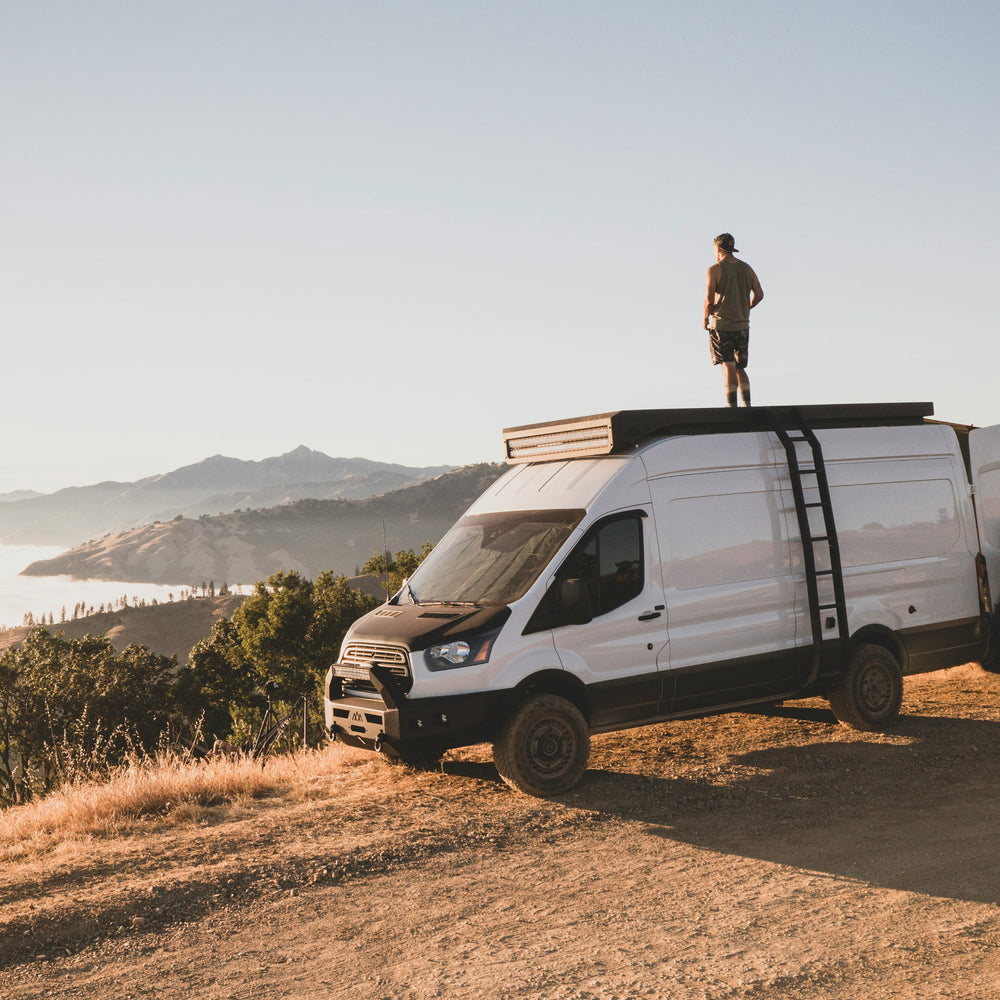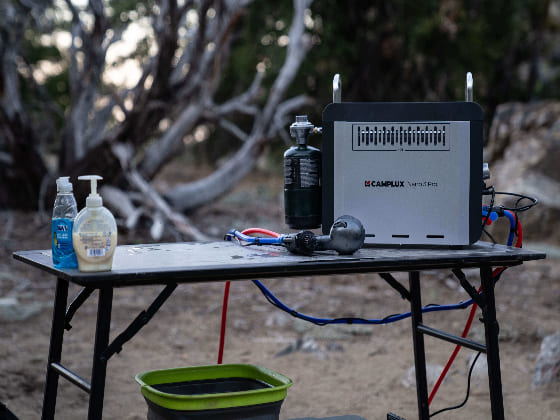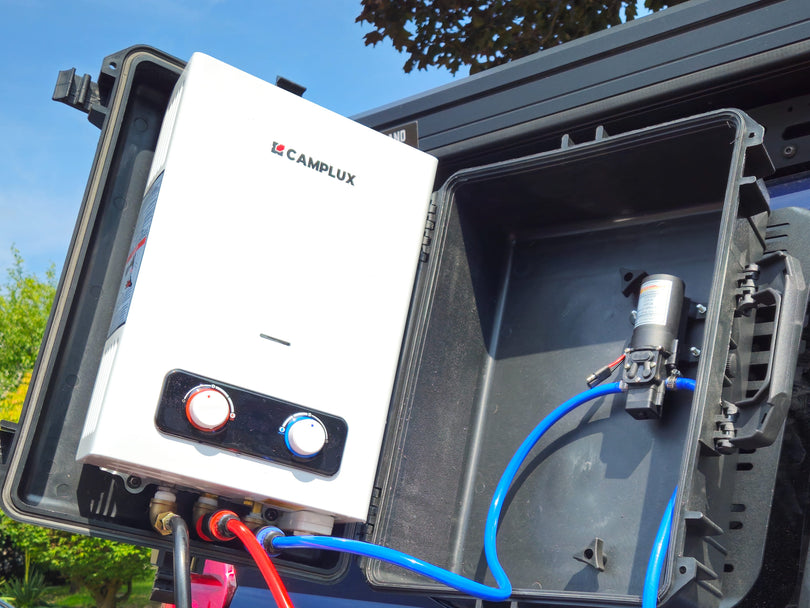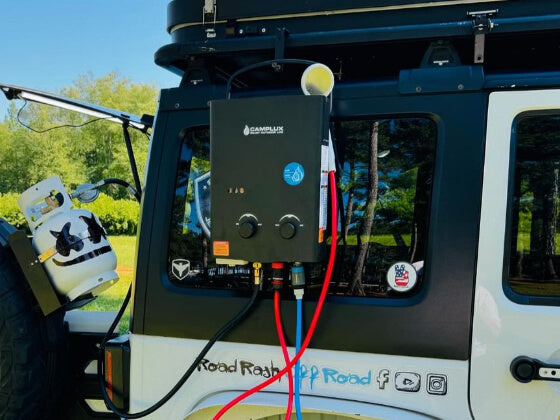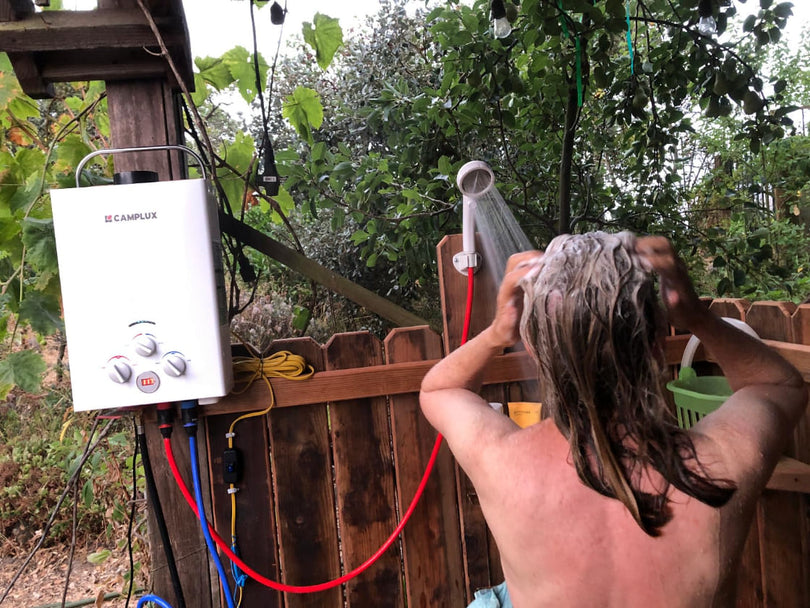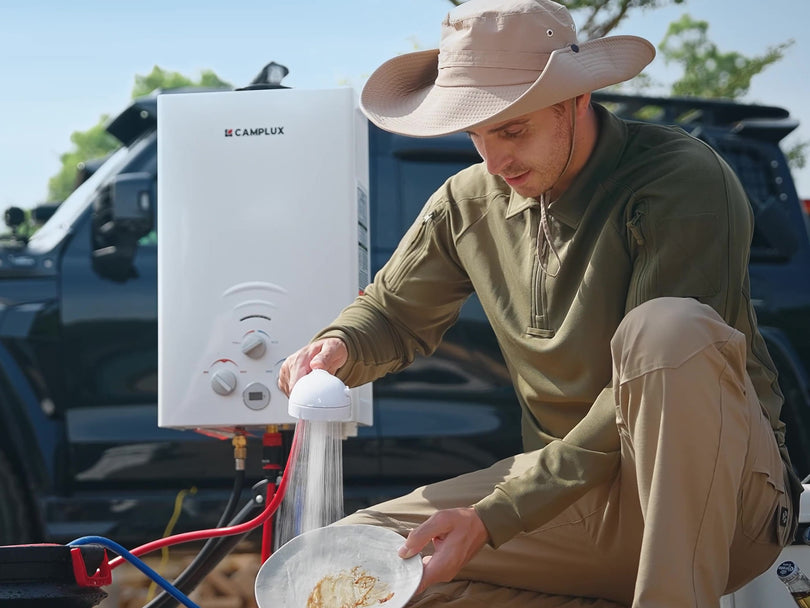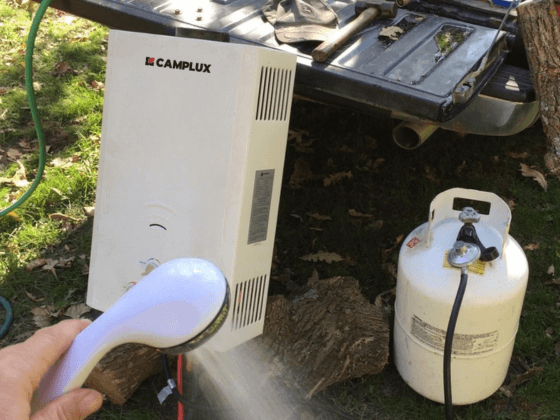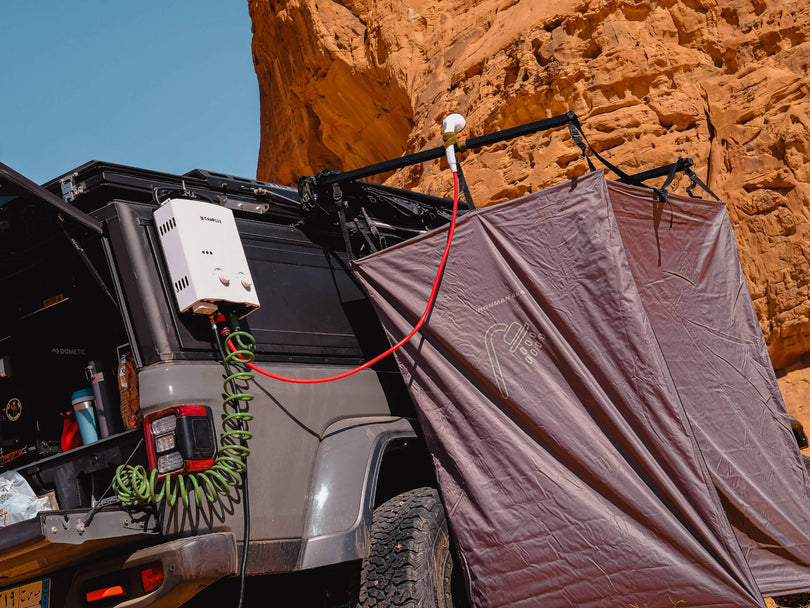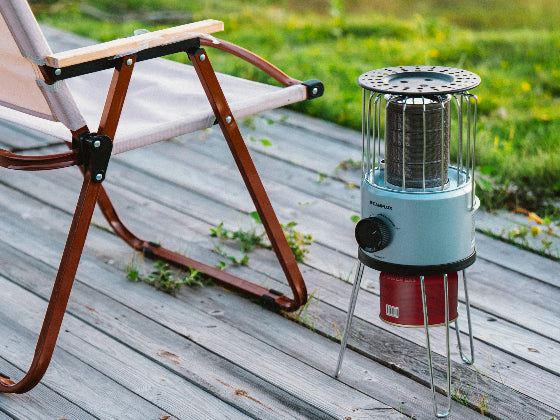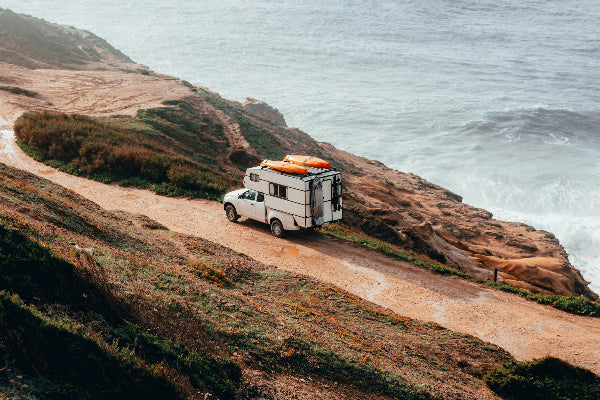Nothing beats a hot shower in the great outdoors after a long day of camping or caravanning. Camplux outdoor water heaters – like the popular Camplux Nano 3Pro, Camplux AY132, Camplux AY132B, and Camplux BW264C – are designed to make off-grid hot water easy. However, even the best portable water heaters can run into hiccups. Don't worry! In this guide, we'll walk through common issues users experience with outdoor tankless water heaters and how to fix them quickly, so you can get back to enjoying your adventure.
Whether you're on a campsite in the Lake District or parked up with your caravan on the Cornish coast, these troubleshooting tips will help you resolve typical problems with your Camplux water heater. We'll also point you to helpful resources (in blue text) on installation, accessories, maintenance, and outdoor use so you can dive deeper into those topics. Let's get started!
1. Ignition Problems – Water Heater Won't Ignite

A Camplux portable water heater mounted outside a camper van. If your water heater won't ignite at all, simple checks can usually get you up and running again.camplux.uk
One of the most common issues is an outdoor water heater that fails to ignite. You turn on the tap expecting hot water, but the water heater doesn't fire up (no clicking sound or flame). Here's what to do, step by step:
- Check the Power Supply: Most portable Camplux water heaters use batteries for ignition. Ensure the batteries are fresh and installed correctly (pay attention to the +/- polarity). A pair of D-cell batteries powers the ignition on models like the AY132 series – if they're spent or inserted wrong, the water heater won't spark. For the Camplux Nano 3Pro (which has a built-in rechargeable battery), make sure it's charged up. A low battery will prevent ignition.
- Confirm Adequate Water Flow: Camplux water heaters require a minimum water pressure/flow to ignite. If your water source is a gravity-fed container or a weak pump, the flow might be too low. Ensure your water pump is on and providing sufficient pressure. A quick test is to disconnect the shower head/hose and run water directly through the unit – this removes any flow restriction. If the water heater ignites with the shower head off, then the shower attachment was likely clogged or limiting flow (clean or replace it). For consistent performance, a small 12V pump is recommended when gravity isn't enough – this is one of the essential camping accessories highlighted in our Essential Accessories for Installing Your Camplux Water Heater guide.
- Check Gas Supply: It sounds obvious, but make sure your propane gas bottle isn't empty and that the valve is fully open. If you've just connected a new gas cylinder, there could be air in the gas line – it might take a few attempts for the air to purge and the gas to reach the burner. Try igniting a couple of times to clear it. Also, double-check that the gas regulator is properly attached with no kinks in the gas hose. (If you suspect a faulty regulator and the unit still won't ignite despite gas in the bottle, swapping to a standard propane regulator is a good troubleshooting step.)
- Verify Inlet Connections and Filters: Ensure the water inlet and outlet hoses aren't reversed – on Camplux portable models the incoming water connects to the right-hand side inlet. If these are swapped, water won't flow through the water heater correctly and it won't start.Next, inspect the little filter screen at the water inlet for debris. Outdoors it's easy for dirt to clog the intake. Clean out any mud, sand, or limescale from the filter. A clogged inlet filter will block water flow and prevent ignition.
- Listen for Clicks: When everything is set correctly, you should hear rapid clicking when you open the hot water tap – that's the igniter sparking. If you hear no click at all, it's likely a power issue (batteries or internal wiring). If you do hear clicking but get no flame, it points to a fuel issue (no gas flow) or too little water flow. Go back over the gas and water steps in that case.
Most ignition failures boil down to one of these factors. Once you've checked power, water, and gas, try starting the water heater again. In the vast majority of cases, your Camplux will fire right up. If not, and you've verified everything above, it might be a more unusual issue – in that rare event, contact Camplux support for further guidance. (You can also see our DIY vs. Professional Installation: What's Best for Your Camplux Water Heater? article if you're unsure about tackling setup or fixes yourself, and when it might be time to call a pro.)
2. Water Heater Ignites but Shuts Off (Flame Goes Out)
Your water heater managed to ignite, but now it cuts off during use – the burner stops and you're back to cold water unexpectedly. This issue can be frustrating when you're in the middle of shampooing your hair outdoors! Common causes for a water heater that starts then stops include gas supply issues, safety features kicking in, or environmental factors. Let's troubleshoot:
- Check the Gas Level: A very frequent culprit is simply running low on gas. When the propane cylinder nears empty, the flame may sputter out or the water heater may shut off because it isn't getting a steady fuel supply. If the flame died, double-check your gas bottle – if it's low, swap in a fresh one and try again. Always carry a spare gas bottle on camping trips so you're not caught out.
- Ensure Stable Water Pressure: Just as low flow can prevent ignition, a drop in water pressure during use can extinguish the burner. For example, if your water source runs dry (empty jerry can) or someone else turns on a tap from the same supply, the flow to the water heater might fall below the minimum and the flame will go out. Maintain a consistent water flow: refill your water container in time or adjust your pump so it provides a continuous feed. If you're using a camper's onboard pump, avoid simultaneously using water elsewhere while someone is showering.
- Beware of the 20-Minute Safety Shutoff: Many Camplux models have a built-in safety timer that turns the water heater off after about 20 minutes of continuous operation.This is a safety feature (to prevent accidentally leaving it running too long). If your hot shower suddenly goes cold around the 20-minute mark, don't panic – it's likely the timer. The solution is simple: turn the hot water flow off, then back on again to reignite the water heater. It will reset and you can continue showering (or perhaps take the hint to wrap up before you completely drain the hot water supply!).
- Overheat or Flame Safety Sensors: All Camplux outdoor water heaters come with safety sensors that will cut off the gas if something is wrong – for instance, if the unit overheats or if the flame is detected as unstable. If your water heater consistently shuts off after a short time, it might be a sensor doing its job. One example is an over-temperature sensor: if you've turned the water flow down too much, the water can get excessively hot, triggering a shutoff. (We'll discuss temperature adjustment more in the next section.) Make sure you're not running the water heater with the water flow at a trickle, as that can cause overheating. Similarly, a flame failure sensor will cut gas if it thinks the flame went out. This could trigger if there's a sudden gust of wind (addressed below) or potentially if the thermocouple is misaligned. While sensor issues are less common, if you suspect it, you might need to have the unit serviced or at least inspect that nothing is physically blocking or bumping the sensor inside.
In summary, if you experience sudden shut-offs: check your gas, keep your water flow consistent, and remember the timed safety shutoff. These simple fixes cover most scenarios. If the problem persists after trying the above, consider reaching out to Camplux customer support – there could be a faulty part (like a gas valve or sensor) that needs professional attention. But in most cases, you'll be back to warm water with a new gas bottle or a quick reset.
3. Wind Exposure and Weather Challenges
Outdoor water heaters have to contend with Mother Nature. Windy conditions in particular can cause trouble: a strong gust can literally blow out the burner flame. If your heater works fine in calm weather but struggles when the wind picks up, here's how to address it:
- Shield the WaterHeater from Direct Wind: Try to position your Camplux water heater in a spot that's out of the direct wind. Even turning the unit slightly or placing it behind a windbreak (like the side of your caravan, a hedge, or a windscreen) can make a big difference. Never fully enclose the water heater, as it needs ventilation, but setting it up in a semi-sheltered spot (such as the lee side of your campervan or a purpose-built stand with side walls) can prevent the flame from blowing out.
- Use the Rain Cap / Wind Shield: The larger Camplux BW264C model comes with a stainless steel rain cap that fits on the top vent. This isn't just for rain – it also helps guard the burner from wind gusts. If you have this model, always install the rain cap during use; it can prevent the flame from extinguishing in breezy conditions and also keep out leaves.For other models, Camplux offers accessories like protective covers and shields that are worth considering if wind is a frequent issue. (See our Essential Accessories for Installing Your Camplux Water Heater article for a rundown of useful add-ons like covers and wind guards.)
- Mind the Cold and Wet: Wind often comes with other weather issues like rain and cold. Heavy rain can potentially splash into an outdoor unit and cool the burner, so try to use the water heater under some overhead cover if it's tipping down. A simple tarp or the caravan awning can help – just ensure there's plenty of ventilation around the unit to safely exhaust. Cold weather is another consideration: if the temperature is near freezing, water inside the waterheater could freeze when it's off, causing damage. Camplux water heaters have drain plugs – use them to empty the unit after use in cold conditions. (For winter camping, you might also want to read our guide on winter-proofing, such as Routine Maintenance Tips for Camplux Outdoor Water Heaters, which touches on winter storage and protection.) While UK winters are mild in many areas, nights can drop below 0°C in the highlands or moors, so it's worth a mention.
By being mindful of wind and weather, you can avoid most climate-related hiccups. In short, keep the flame sheltered from strong gusts, use the rain/wind cap if provided, and protect your water heater from extreme elements when not in use. Camplux outdoor water heaters are built to handle British weather, but a bit of preparation will ensure a warm shower even on a blustery day!
4. Water Temperature Fluctuations (Too Cold, Too Hot, or Intermittent)
Sometimes the water heater is running, but the water temperature isn't quite right. Maybe the water isn't getting hot enough, or it's scalding hot, or it keeps going hot and cold in cycles. Let's break down these temperature issues and how to fix them:
Water Not Hot Enough: If your Camplux is igniting but the water is only lukewarm or cooler than expected, first check your temperature settings. Portable models usually have a gas flow knob and a water flow knob. To increase water temperature, turn up the gas (more fuel = hotter flame) and turn down the water flow (slower water gives it more time to heat). It's a balance – try adjusting both knobs to find the sweet spot. Also consider the source water temperature and your water heater's capacity. In winter or early spring, UK tap water or stream water can be very cold (near 5–10°C), and a small 5L water heater might only heat that up to maybe 30–40°C – warm, but not piping hot. In such cases, reducing the flow will help increase the output temperature. Ensure you're not exceeding the water heater's flow rate – if you run the water faster than the unit's rated GPM (gallons per minute or L/min), it won't have enough time to heat properly. Lastly, make sure you're not using a long gas hose or splitting the gas supply between multiple devices. Very long gas lines can drop pressure by the time gas reaches the water heater, resulting in a weaker flame. Using the proper regulator (typically 37 mbar for UK propane) and keeping the gas line reasonably short will ensure the water heater gets enough fuel to heat at full capacity.
- Water Too Hot / Overheating: On the flip side, you might encounter water that's scalding hot or hotter than expected, sometimes followed by the water heater shutting off. This often happens if the water flow is set too low or restricted. When water trickles through, the water heater can spike the temperature very high. If you notice dangerously hot water, immediately increase the flow a bit or dial down the gas knob. Aim for a moderate setting where the water is comfortable to the touch and stable. Remember, Camplux water heaters have an overheat protection – if water exceeds a certain temperature (around 75°C), the unit will auto-shutoff to prevent scalding. So if you had it set to max flame and min flow, the water heater might cut out (as discussed earlier). Prevent that by not running the unit at extreme settings. Pro tip: If you only need a lower temperature (for example, washing hands or a warm shower on a mild day), don't run the water heater at maximum – it's okay to throttle it to a lower flame. You'll save gas and avoid any chance of overheating.
- Temperature Fluctuates (Hot and Cold Cycling): Some users report the water temperature oscillating – hot, then cold, then hot again. This can be quite annoying in the shower. A common cause is that the water flow is right at the threshold of what's required to keep the water heater running, leading it to turn on and off repeatedly. For instance, if you have a shower head with a trigger or an adjustable spray that's partially closed, it might reduce flow just enough that the water heater turns off, then water pressure builds, it turns back on, and so forth. To fix this, ensure a steady flow rate: fully open the shower tap or don't half-close the shower head valve. It's better to set the temperature via the water heater knobs than by partially closing a tap on the outlet. Another cause could be fluctuations in supply pressure – if you're using a pump that pulsates, you might experience variation in flow. Using an accumulator tank or a higher quality pump can smooth this out. Also, check your gas cylinder – as propane in the bottle gets low or very cold (propane evaporates more slowly in cold weather), the gas pressure can drop and cause the flame to weaken intermittently. In cool weather, a near-empty cylinder might not maintain a steady output. The cure is to swap to a fresh cylinder if you suspect this. Keep in mind that wind gusts can also cause momentary flame changes – if you're in a very windy spot, refer to the wind protection tips above.
In general, once you've dialed in your water heater settings for the desired temperature, Camplux water heaters will maintain a consistent output. If you're still struggling to get a stable temperature after trying these adjustments, give the unit a quick maintenance check: sediment buildup (limescale) inside the water heater can impact heating efficiency over time. Flushing the water heater with a descaling solution periodically (as described in our maintenance guide) can restore proper heat exchange.
5. Low Water Pressure or Flow Issues

A Camplux tankless water heater set up outdoors with its shower attachment. Ensuring sufficient water flow is key to proper operation – portable pumps and clean hoses help keep the hot water coming.
Using an outdoor water heater in remote locations often means you're drawing water from a portable source – a jerry can, a foldable tank, or a nearby stream. Low water pressure is a common challenge in these setups. If your water heater is not igniting or is shutting off and you suspect weak flow, consider the following:
Use a Water Pump: While some campers try to run water heaters purely on gravity (e.g. elevated water containers), most tankless units like Camplux really benefit from a 12V water pump to provide consistent pressure. Camplux's smaller models typically need around 2–3 PSI minimum to trigger ignition (that's roughly 0.2 bar). A pump that provides ~35 PSI (2.5 bar) will ensure excellent performance.In fact, many portable pumps are in this range. The Camplux Nano 3Pro comes with its own 12V pump included, which is handy. For models like the AY132, if you're camping off-grid, invest in a good pump and a small leisure battery or use your vehicle's 12V outlet. Your shower experience will be much more reliable.
- Check for Kinks and Elevation: If you don't have a pump and must rely on gravity, make sure your water container is as high above the water heater as practical (to increase head pressure). Also ensure the hose has no kinks or sharp bends that might be choking the flow. Even with a pump, any constriction in the hose line can reduce effective pressure by the time water reaches the water heater. Use the hose provided with the water heater or one of equal diameter – don't swap it for a narrower hose.
- Clean the Water Filter: As mentioned earlier, there's a filter at the water inlet of the water heater to trap debris. If you're pumping water from a river or lake, that filter can quickly collect sand, leaves, or sediment which will reduce your flow rate. Regularly inspect and rinse the filter. It only takes a minute and can make a big difference in water pressure through the unit. If you're in a location with very dirty water, consider a pre-filter on your intake hose as well.
- Mind Any Elevation Gain: Remember that if you're pumping water uphill to the water heater (say your water source is below and the water heater is mounted higher), the pump has to work against gravity, effectively lowering the pressure at the water heater. Try to keep the water heater at roughly the same level or lower than the water tank/pump to maximise pressure. Also, keep your water hoses as short as is reasonable for your setup – long runs of hose can lead to pressure loss.
- Symptoms of Low Pressure: If you open the hot tap and the water heater sometimes fires but not always, or it fires only when you disconnect the shower head, that's a telltale sign of marginal pressure. The flame may also stutter if pressure is right on the edge. By ensuring a strong, steady flow (with the tips above), you'll eliminate these issues.
Overall, adequate water pressure is crucial for portable tankless water heaters. Once you set up a solid water supply (pump, decent hoses, clean filter), your Camplux will reward you with instant hot water at the turn of a tap. For more on setting up your water heater system, including pumps and other gear, check out our Step-by-Step Guide: Setting Up Your Camplux Portable Water Heater for Camping (it covers installation and accessory tips to get the best performance).
6. Strange Flames, Noises, or Smells
Finally, let's address a few less common issues that you might notice: unusual flame appearance, odd noises, or smells from the water heater. These aren't everyday problems, but it's good to know what to do if they arise:
Yellow or Sooty Flame: The burner flame of a healthy gas water heater should be mostly blue. If you observe a yellow flame or black smoke/soot, it indicates incomplete combustion. This can happen if the burner is dirty or if the air intake is blocked (the water heater isn't getting enough oxygen). First, turn off the water heater immediately if you see black smoke – you don't want soot buildup or carbon monoxide risk. Once it's cool, check the burner area for any obvious debris (insects or spider webs in the burner slots are a known issue in outdoor gear). You can try gently blowing out the burner and heat exchanger with compressed air to clear any dust or cobwebs.Also ensure the water heater isn't being used in a confined space starving it of air – remember, outdoor use only. After cleaning, test the unit again. If the flame is back to blue, you're all set. If it's still yellow or smoking, it's best not to use the water heater until it's serviced, as that means it's not burning correctly (there could be an internal blockage or wrong gas pressure).
- “Pop” or Loud Ignition Bang: Sometimes, especially after changing gas bottles or after the water heater hasn't been used in a while, you might hear a loud whoosh or pop when it finally ignites. This can be due to a small gas build-up before ignition (like a mini backfire). To minimise this, make sure you've purged air from the gas line – open the gas valve and try igniting a couple of times promptly. Usually, the first ignition after connecting a new cylinder might stumble, but subsequent ones will be smooth. Also check that the gas regulator is functioning properly. If you consistently get a loud ignition bang, try using a different propane regulator (a standard 37 mbar regulator for the UK). A faulty regulator could be letting too much gas through initially. Additionally, ensure the water heater is mounted securely. If it's rattling or not firmly hung, the sudden ignition can cause the unit to jolt and make noise. Tighten any mounting screws or brackets – the water heater should be stable on the wall or stand.
Gas Smell (Rotten Egg Odour): If you ever smell unburned gas (that distinctive rotten egg or sulphur smell) around the unit, shut off the gas supply immediately. A gas odour could mean a leak in the hose or connections. Never ignore this. Turn off the propane cylinder, ventilate the area, and then inspect all connections with a soapy water solution. If you see bubbles, you've found a leak – tighten the connection or replace the faulty part before using the water heater again.All connections should be snug but not over-tightened (use a spanner to tighten fittings firm, but avoid stripping threads). It's good practice to perform this soap test on new setups. Also, ensure you are using the correct gas type – these Camplux models run on LPG (propane/butane). They should not be hooked to mains natural gas. Using the wrong gas or a regulator for the wrong gas can be dangerous and cause malfunctions.
By keeping an eye (and ear and nose) out for these signs, you can catch potential issues early. In normal operation, your portable water heater will have a steady blue flame and a gentle sound of burning – no roaring, no strong smells beyond maybe the first second of ignition. If something seems off, it's always better to be cautious: turn it off, troubleshoot with the tips above, and if needed, seek expert advice.
Enjoy Outdoor Hot Water with Confidence
With a little know-how, you can resolve most common problems with your outdoor water heater and continue to enjoy hot water wherever you roam. The key is to remember the basics: battery, water flow, gas supply, and environment. Camplux designs its water heaters for hassle-free outdoor use, so troubleshooting is usually straightforward. A spare battery, an adequate water pump, and keeping an eye on your gas levels will prevent 95% of issues campers face.
For further reading and to deepen your knowledge, you might explore our other resources. If you're setting up your water heater for the first time or looking to upgrade your campsite, don't miss our guides on How to Install a Camplux Outdoor Water Heater in the UK and the earlier-mentioned accessories checklist. To keep your water heater running smoothly for years, follow the Routine Maintenance Tips for Camplux Outdoor Water Heaters (simple upkeep like cleaning filters and descaling can make a world of difference). And for inspiration on how a portable water heater can transform your camping or vanlife experience, check out why many adventurers say Camplux is the ultimate outdoor hot water solution in our Camplux Hot Water Heater – Ultimate Solution for Outdoor Adventures article.
Authentic outdoor living is all about enjoying nature without giving up comfort. With your Camplux water heater and these troubleshooting tips in your back pocket, you can confidently take warm showers under the stars, wash up with hot water at the beach, or bathe the dog after a muddy hike – all without a hitch. So go ahead and embrace the outdoors, knowing that a hot shower is always within reach! Happy camping and enjoy the outdoor life with Camplux.
